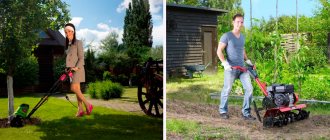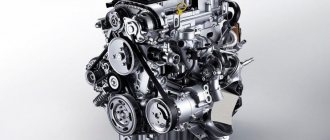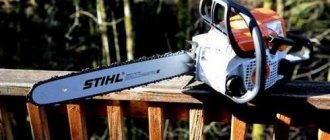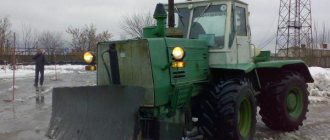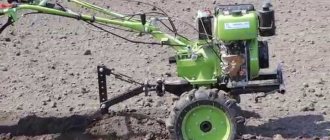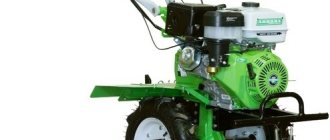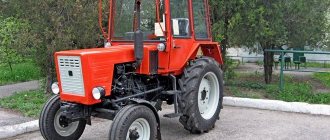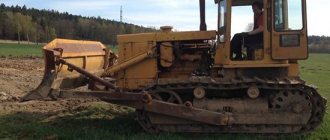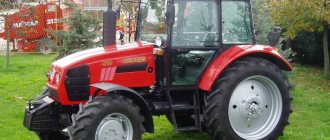If you have to cultivate large areas of soil, it is not always convenient to do this with a shovel or other hand tools. In this case, it is better to use a cultivator, the choice of which depends on several factors and conditions.
First, it’s worth defining the concept of “cultivator”. This is a specialized gardening equipment, the main purpose of which is the treatment (cultivation) of the upper sections of the soil by loosening it. Here there is often confusion regarding the question of what is a cultivator and what is a walk-behind tractor, another popular type of equipment. A walk-behind tractor is a heavy multifunctional agricultural equipment, weighing from 70 kg, equipped with an internal combustion engine and capable of performing a full range of agricultural work: cultivation, hilling, plowing, potato harvesting. When purchasing additional attachments, walk-behind tractors are also capable of removing snow, mowing grass, watering the garden, transporting goods using trailers, and so on. That is, a walk-behind tractor can be a cultivator, but not vice versa.
The advantage of a cultivator compared to walk-behind tractors is maneuverability, lightness (light weight) and fuel economy. In a garden or vegetable garden, this technique is indispensable for digging, loosening and weeding: it has proven itself well when cultivating the soil of greenhouses, flower beds, the ground between trees and rows of vegetables, under bushes.
Cultivator device
A standard cultivator consists of a frame on which the engine, transmission, working shaft with working tools, control handles, one or two transport wheels, and a protective visor are mounted.
The main working tool when working with cultivators are tillers. For most cultivator models, they are made as connections of two, four or six fairly easily removable sections. By selecting their number, they create the processing width required at this stage of work. The rotation of the cultivator cutters leads to cutting the soil into layers, crushing them and mixing them. In this case, the cultivator does not have drive wheels; it moves forward with the help of cutters, which also move, “push” it forward and cause movement.
In addition to the standard tillers described above, cultivators can, if desired, be equipped with a variety of attachments, which significantly expand the possibilities of performing agricultural work on them. Of course, such an additional “attachment” is purchased separately by the owners of the cultivators, so when choosing a cultivator for purchase, it will be useful to compare not only their technical parameters, but also the range of their equipment, their compatibility with various attachment options.
Operating principle of the KPS-4 cultivator
After entering the area being worked, the operator lowers the cultivator's arms to the working position using the hydraulic system. Since the paws are located at a certain crumbling angle, as well as under the influence of the massive weight of the unit and the speed of its movement, they enter the soil to the required depth. At the same time, the blades of the paws trim and crumble the stems and roots of weeds.
The soil from the upper soil layer rises up the paws and, falling from them, crumbles into small lumps, which are evenly distributed over the surface of the field, leveling it. To enhance this effect of breaking the soil into small lumps and leveling the surface, the KPS-4 cultivator is equipped with tooth harrows.
"KPS-4", with tooth harrows.
The tillage depth is adjusted on the cultivator using support wheels. If the wheels are raised, the working depth will increase, and vice versa. The wheels are raised and lowered using an adjustment mechanism. The working parts of the cultivator - the paws - are arranged in a checkerboard pattern. The ends of the cutting edges of the hind paws on each side should overlap the edges of the front paws by 7 cm to ensure complete destruction of the root system of weeds. The uniformity of the processing depth can be adjusted by preloading the spring on the rod. If the spring is compressed, the depth of the paw stroke increases. And also by changing the position of the stand on the beam: loosen the stepladder and move the stand.
Several trailed cultivators can be combined using hitches into large wide-cut units for working with tractors of 3-5 traction classes. And the mounted version of the KPS-4 cultivator was developed specifically for cultivating particularly heavy and rocky soils. This modification is equipped with reinforced paws with spring guards.
engine's type
Engines can be gasoline, diesel, electric. Gasoline engines, in turn, can be two-stroke or four-stroke. Electric motors can be powered either from the mains, that is, they must be constantly connected to an outlet using an electrical cable of the required length, or from a built-in battery.
Electric engines and two-stroke gasoline engines are usually used in light class cultivators. Four-stroke gasoline and diesel engines are installed on medium and heavy class cultivators. The difficulty of operating cultivators with a gasoline engine is the need for constant maintenance. Fuel should be added regularly and oil should be used to lubricate parts. In addition, each model requires certain brands of oil and fuel, so you must strictly follow the instructions. Compared to electric models, gasoline models make too much noise. It is worth remembering about gasoline exhausts, harmful plants, soil and people. Models with a two-stroke engine are cheaper and simpler, but they require more fuel.
Electric cultivators do not have as much power as models with an internal combustion engine, but are great for small areas. Also, according to the observations of some users of electric models, vibration can irritate bees if work is done near the apiary.
Petrol cultivator Crosser CR-K12
Diesel cultivator ZIGZAG DT 902
Electric cultivator FERMER F-105
How to create a cultivator with your own hands
Hand cultivator
Not all landowners can afford to purchase a cultivator, so many of them assemble the equipment with their own hands. The simplest one, to make it you will need:
- pitchfork;
- hammer;
- plastic pipe 0.5 m;
- handle for shovel handle;
- insulating tape.
You need to take a pitchfork and, using a hammer, carefully bend the teeth so that they resemble a kind of corkscrew . The plastic pipe must be cut lengthwise. A handle is placed on the handle of the fork, and a cut pipe is placed on it. The assembled handle is secured with electrical tape to prevent it from slipping.
Engine power and transmission type
Power is expressed in horsepower, and depending on their quantity, such devices are divided into three types: light (up to 4 hp), medium (4-6 hp) and heavy (more than 6 hp) devices. Typically, the power of a cultivator is directly related to weight. The greater the power of the device, the easier and faster it cultivates the land. Engine displacement – for models with a gasoline unit. The “golden mean” rule applies here. A very weak engine with a small displacement will not be able to cope with an average load. A large and powerful engine will consume a lot of fuel. The amount of fuel consumption ranges from 1-2.5 liters per hour of intensive work.
The transmission transmits rotation from the engine to the working tools - cultivator cutters. The transmission also includes a clutch. This is a device that allows you to turn on and off rotation from the engine to the working body. The following types of transmissions are used in cultivators: gear-worm transmissions, belt-tooth-chain transmissions and some others.
Lightweight cultivator Krones GHA35
Medium-power cultivator MTD T/245
Heavy cultivator Skiper SK 700
What is a cultivator?
A cultivator is a garden equipment that cultivates the land before sowing and after harvesting. With its help you can plow and loosen the soil, destroy weeds, and apply fertilizers. In addition, it is designed for processing row spacing, hilling plantings and thinning.
Cultivators are divided into:
- electrical;
- gasoline;
- manual.
They also differ in weight and power:
- ultra-light - equipment weighing no more than 30 kg is designed for work in small garden plots;
- lightweight - units weighing 30-60 kg can process large plots of land. They can be used on a plowed field and on virgin soil;
- medium - equipment weighing 60-100 kg;
- heavy - cultivators weighing more than 100 kg, cultivate large agricultural lands.
Maximum width and depth of cultivation
Tilling width is the maximum strip width that the cultivator can cover. A very narrow coverage adds time that is required for high-quality soil cultivation. The width of the processed strip depends on the engine power. Approximately 1 hp required for twenty centimeters of land covered in width. A wide grip is more convenient for processing large areas of land. If weeding between beds is important, then a narrow grip is more convenient.
The tillage depth reflects the distance to which the cultivator cutters penetrate the soil. As a rule, it is directly proportional to the diameter of the cutters. In some cases, the manufacturer separately indicates the cutting depth and cutter diameter. The average value usually does not exceed 25 cm. The tillage depth is set by the adjustable position of the coulter (a strong metal strip that is vertically fixed to the rear of the cultivator). The cutting width is usually adjusted by installing various cutters.
Cultivator with a maximum cultivation width of 1050 mm ZIGZAG GT 903
Cultivator with a maximum cultivation depth of 350 mm Workmaster WT-85
Technical characteristics of "KPS-4" in numbers
Diagram of the KPS-4 cultivator.
- Productivity: 3.9 - 4.8 hectares per hour;
- Working width: 4 meters;
- Operating speed: 9–12 kilometers per hour;
- Travel speed in transport position: 15 km/h;
- Processing depth: 5 – 12 centimeters;
- Weight: 690 – 927 kilograms;
- Number of working bodies (racks/disks/cases): 16 pieces;
- Distance between racks/disks/cases: 25 centimeters;
- Distance between adjacent grooves: 16.6 centimeters;
- Tractor traction class for aggregation: 1.4-2;
- Air pressure in the studs of the support wheels: front – 0.17 MPa; rear – 0.1 MPa;
- Overall dimensions (length x width x height), without tine harrows: 4.98 x 4.095 x 0.95 meters;
- Ground clearance: at least 300 mm.
Types of cutters and their speed
The main tool when working with cultivators are tillers. For most cultivator models, they are made as connections of two, four or six fairly easily removable sections. By selecting their number, they create the processing width required at this stage of work. Of course, when work is to be done on heavy, clayey soils, the number of installed sections of soil cutters will need to be reduced. Moreover, it will be important to do this in cases where a cultivator will have to plow up virgin soil or restore agricultural cultivation of a long-abandoned site.
Milling cutters can be either non-separable or collapsible. It is better to choose collapsible knives, since they can be easily replaced if necessary. There are two types of cutter design: “crow’s feet” and with saber-shaped knives.
The last option is the most popular and can be called standard. After all, these types of products are time-tested: their effectiveness is quite high. They have the optimal shape and material. The knives are made from high-quality, high-strength steel.
As for crow's feet products, such products are used for hard soils. They have a solid structure, non-dismountable, due to this their strength is high. Such products are effective in controlling weeds and processing virgin soil. It should be noted that the cutter is a self-sharpening tool. No additional manipulations in this direction are required.
The optimal cutter speed for cultivators is considered to be 150-170 rpm. At this speed of rotation of the cutter, deep cultivation can be done to a depth of up to 15 centimeters. At 200-220 rpm, you can loosen the top layer of soil to a depth of 8-10 centimeters and do pre-sowing cultivation to a depth of 6 centimeters. And increasing the speed to 275-330 ensures effective loosening of row spacing and destruction of the soil crust.
Cultivator with saber blades SunGarden T/35
Cultivator with houndstooth cutters Zigzag GT 134
Which cultivator to choose: gasoline, electric or battery
What is the task, so is the answer:
- Electric motors are cheaper not only to purchase, but also to operate. There are no harmful emissions or noise from them, and they do not require topping up fuel. But, unfortunately, the power of this engine is low. Another drawback is the presence of an extension cord that gets tangled underfoot (you will also have to buy it). When working with this type of engine, it is important to observe safety rules: under no circumstances work in rain or high humidity and monitor the wire, as there is a risk of damage to it by the cutter. And this will lead to electric shock. But an electric cultivator is the best option for owners of a small garden where large and large-scale plantings are not required;
- Gasoline-powered models cover large areas. Their advantage is that they do not require an electrical network; they can even work in an open field. Another advantage is higher power, the ability to plow even untouched land. Plus, they are equipped with reverse gear (additional reverse gear). The disadvantage is noise, harmful emissions and high operating costs. In addition, to work with such a cultivator, you need to have some experience;
- Battery-powered models are not so popular among gardeners because their power is low. This technique is only suitable for small areas. Motor cultivators with a battery are attractive because they can be used in any territory, at any distance. But as soon as the battery runs out, plowing will have to stop. This is the main disadvantage, there are others. The battery lasts for a short period of time, the width and depth of plowing is minimal. But if you prefer environmentally friendly equipment, we recommend purchasing the Greenworks G-MAX model with a 40-volt battery with a capacity of 6 Ah.
Number of speeds
The number of forward speeds allows you to adjust the speed of the cutter and determine the type of work with the soil as described above. On modern cultivators, it is desirable to have a reverse gear. Light and ultra-light models, of course, do not have reverse gear, but they have a special handle to make it convenient to lift the cultivator and turn it in the right direction. This will be especially useful when working near various obstacles (fences, for example) or in some narrow, limited areas when you constantly need to make an effort to rearrange the cultivator. Heavy class devices weighing more than 60 kg have reverse as standard.
Reverse cultivator FERMER FM-701MS
What is the difference between a walk-behind tractor and a walk-behind cultivator?
A motor cultivator belongs to a technique with a narrower focus. The soil is plowed using it using special cutters. Cutting elements are included in the assembly. The motor cultivator is lighter, more convenient and compact.
Many people confuse them; in fact, they are completely different cars. A walk-behind tractor, unlike a walk-behind cultivator, is capable of performing many agricultural jobs. In addition, you can connect a trailer or canopy to the walk-behind tractor.
The walk-behind tractor is a kind of station wagon. Its functions and operating principle depend on the type of hinged structure. This is a strong technique that can cope with soil of any complexity. Components of a walk-behind tractor:
- Mills;
- Mower;
- Snow blower and others.
The cutters also come assembled with the device, so you don’t have to wait long to plow the ground. As for professional equipment, additional elements are not included. The buyer selects and buys them separately. A significant difference between a walk-behind tractor is that it has a pulley or shaft, which allows the rotation of the motor to be transmitted to the active body kit.
What else is different:
- Weight. The minimum weight of the machine starts at 70 kg and reaches 2 or 3 centners. The motor cultivator is much lighter: 70 kg is almost its maximum;
- The design is reliable and convenient;
- Gearbox with two forward and one reverse speeds. Cultivators do not have it;
- If desired, the direction of the cutter can be changed;
- Pneumatic wheels necessary for transportation from one place to another. After all, a walk-behind tractor is heavy equipment. The difference between a motor cultivator and a walk-behind tractor is the presence of only small wheels. Only heavy-duty models have pneumatic wheels (they can be installed for an additional fee).
Field continuous tillage cultivator KUPE-4PV
Designed for fallow care and pre-sowing soil treatment. A pointed paw with a processing width of 330 mm is used. Double-row arrangement of working bodies. Possibility of aggregation in a hitch.
Structure of KUPE-4PV
What does the cultivator itself look like? Well, firstly, all the working parts are located on it in 4 rows. The process of tillage occurs in the same way as in any other model: the soil falls under special rollers, which either compact it or saturate it with something. In CUPE, something else happens: after the tractor passes through the soil, you can start the cultivator and watch how the special track breaker is able to separate the compacted soil.
The components also include a spring-mounted harrow consisting of two rows. It is here that it is possible to install aggregated equipment that allows you to expand the functionality of the cultivator. In particular, we are talking about the grinding roller and the BZSS attachment, which are used for slightly different purposes, in contrast to the initial use of KUPE-4PV.
The design of the cultivator, as well as its functionality, were developed for a reason, but with specific goals in mind. And, it should be noted, the manufacturer has clearly achieved them.
Technical equipment
All models of cultivators that go on sale in one way or another have analogues - basic models, on the basis of which modernizations are formed and new technical characteristics are added. For KUPE-4PV these characteristics are:
- a pointed paw with a width of 330 mm;
- trace loosening agent (its capabilities are described above);
- Possibility of mounting aggregated equipment.
There are two options for working bodies:
- an “S” shaped strut with an active spring;
- a stand in the shape of the letter “C”, which is based on a hinge-spring assembly.
What types of cultivators are there for continuous tillage?
In agriculture, continuous tillage cultivators are often used to destroy all kinds of weeds in the fields. These devices are attached to a tractor and follow it around the site, cutting and destroying weeds, cutting furrows, and hilling plants (image No. 1). The soil does not turn over, and cultivation occurs to the depth of future seed placement.
Image 1. Hilling up plants using a cultivator.
Working bodies of row-crop cultivators
On plant feeder cultivators, depending on the processing tasks, crop, soil and climatic conditions, sowing method and plant age, various working parts are used. Weeding paws are used to cut weeds and loosen the soil between rows to a depth of 6 cm. Razors are usually used for the first inter-row cultivation and for bouquets. Attached to the razor stand is a one-sided flat-cutting blade with a vertical jaw that protects the plants from being covered with soil. There are left- and right-handed razors. The first ones are installed on the left, and the second ones on the right side of the row so that the cheek is located on the sides of the row. The cutting width of the razors is 85, 120, 165 and 250 mm. The angle of installation of the blade to the plane of the cheek is 28-32°, and the angle of installation of the plane of the blade to the surface of the field is 15°. The razor blade cuts the roots of the weeds, the soil moves along its working surface and crumbles. Universal pointed paws cut weeds and intensively loosen the soil to a depth of 12 cm. They are used both for continuous cultivation and for inter-row cultivation. A double-sided blade with sharp edges is attached to the paw stand. Working width 220-385 mm. The crumbling angle is 28-30°, the angle between the cutting edges of the blades is 60 and 65°. Chisel-shaped paws are used for loosening row spacing to a depth of 16 cm. The toe of the stand, bent forward, ends in a pointed chisel 20 mm wide. Such a paw penetrates well even on hard and highly compacted soil, deforms and loosens a layer of soil wider than the width of the toe and does not carry wet soil to the surface of the field. The feeding knife is used for loosening row spacing and embedding fertilizers into the soil to a depth of 16 cm. It consists of a chisel-shaped paw and a funnel attached to it, through which fertilizers spilling out of the fertilizer line fall to the bottom of the furrow. Moldboard paws are used for inter-row processing of potatoes and other crops. A blade with a curved surface and sharp edges is attached to the stand. Right- and left-sided plow blades are installed at a distance of 25-27 cm on both sides of the row axis. Moldboards cut weeds and loosen the soil to a depth of 6 cm, move some of the soil from between rows to protective zones and cover the weeds with it.
The hiller body is designed to form a ridge along the axis of the row, destroy weeds at the bottom of the furrow and cover weeds in protective zones. A tip and a double-sided blade with sliding wings are attached to the rack. The soil, cut with a razor, rises along the working surface of the dump, is loosened and raked with wings towards the row of plants. The grooves allow you to change the position of the wings in height, i.e. adjust the height of the soil shaft formed by the hiller. The ridge tip with a lattice blade is made in the form of a pointed paw. Through the gap between the tip and the blade, the soil spills into the furrow, forming a loose bottom. The blade fingers loosen the furrow walls and ridge sides. Lattice dumps should be used in conditions of insufficient moisture. The depth of cultivation with the hiller is up to 16 cm, the height of the ridge is up to 25 cm. The furrow cutter is used for cutting irrigation furrows up to 20 cm deep with the simultaneous application of mineral fertilizers during inter-row cultivation of row crops in irrigated agriculture. It consists of a stand, a tip, a double-sided blade, wings and funnels for applying mineral fertilizers. The height of the wings can be adjusted.
Rotary needle discs are used to destroy the soil crust and destroy weeds in row-spacings and protective zones when processing row crops. The needle disc section consists of a frame on the axis of which discs with curved teeth rotate. The discs move along the protective zones of the rows, and the teeth, buried up to 9 cm, loosen the soil and destroy weeds. The discs can be installed with the convexity of the teeth in the direction of movement or against. In the first case, the discs destroy weeds more intensively. Weeding harrows are used to loosen the soil and destroy weeds at the same time in protective zones and between rows when cultivating tall-stemmed row crops. Spring teeth are attached to the frame. The number and spacing of teeth can be changed. For processing protective zones, six teeth are attached to the frame, and for processing row spacing - nine teeth. The penetration of the teeth into the soil is controlled by a spring. The shields are placed above the row of plants so that they are not covered with soil during the first cultivation or when working at high speed. The shield is a curved sheet with a bracket for mounting on the section beam. The universal rotary harrow BRU-0.7 is used for pre-emergence loosening of the soil, leveling the tops of ridges before sowing, destroying weeds in potato plantings, sowing root crops and other crops cultivated on ridges. The harrow section consists of a frame, a spring-loaded stand, a holder ,
cranked axis, two drums with conical and cylindrical surfaces, on which teeth 55 mm long are fixed. In addition, cylindrical smooth drums are attached to the sections. Tooth drums are used to loosen the soil and destroy weeds, while smooth drums are used to roll down the tops of ridges and their walls. By turning the holder axis, the inclination of the drum axis to the comb wall and the direction of movement are changed. For pre-sowing harrowing, the drum axis is positioned horizontally. The PPR-5.4 device is intended for cultivating row crops using Astrakhan industrial technology, which involves cutting guide slots, applying and embedding herbicides using a belt method during pre-sowing tillage, planting along guide slots, as well as loosening the soil and destroying weeds in the row and protective zone during inter-row planting. processing. The device includes slot cutters, furrow cutters, harrows and loops for incorporating herbicides into the soil, weeding rotors, wide-cut flat cutters, weeding discs, protective shields and spring rods. Sets of working parts of the device are installed on row-crop cultivators. Chip cutters are also installed on seeders and planters.
Gap cutter
It is a flat handle knife, hard-alloyed in the working part.
The knife ensures cutting of cracks up to 35 cm deep. The weeding rotor
is used to loosen the soil and destroy weeds between rows with minimal protective zones. The rotor consists of a stand, a disk and rippers equipped with teeth. The disc is mounted on the axle by means of a bearing, and the ripper is mounted on the axle. Because The rotor disk is inclined to the field surface, then the rippers near the row of plants are buried in the soil, and those on the opposite side are deepened. During movement, the rippers, engaging with the soil, rotate and at the same time rotate the disk, the teeth loosen the soil, comb out weeds and cover them with soil. When the plant height is less than 50 mm, a protective shield is attached to the bed to prevent soil from covering the cultivated plants.
Weeding disc
used to treat protective zones with overgrown leaf surfaces of plants.
The disk ,
attached to the end of the blade of a wide-cut flat-cutting paw, has six knives with double-sided sharpening.
During operation, the disc and blade of the paw are buried in the soil. Clutching the knives with the soil, the disc rotates, cuts the root system of weeds and loosens the soil in the protective zone of the rows.
Combine harvesters
Combine harvesters are designed for harvesting cereal grain crops. When combine harvesters are equipped with special devices, they harvest corn for grain, millet, rhizome, rapeseed, sunflower, soybeans, grass seed crops, sugar beets, vegetable and medicinal crops. Harvesting these crops is accompanied by the following technological processes being performed by combine harvesters: mowing or picking up stems from windrows, transporting them in a harvesting machine; threshing grain from yulse and separating it from straw; cleaning grain from impurities and transporting it to a bunker; collecting straw in whole, crushed, pressed form or scattering it on the field. Harvesters are either trailed or self-propelled. The most common are self-propelled harvesters. Based on the type of threshing and separating working parts, combine harvesters are divided into two groups: with a classic and an axial rotary thresher. The first group includes self-propelled combines SK-5M "Niva", "Yenisei-1200", "Kedr-1200", "Don-161", "Don-1500B", the second - self-propelled combines SK-10V "Rotor", "Don-2600" and trailed combine harvester PN-100 "Prostor".
Let's consider the design and working process of combines of the first group using the Don-1500B combine as an example. The Don-1500B combine harvester consists of a reaping part ,
including a header, a spacer and an inclined chamber, a thresher
,
a hopper
,
a stacker
,
an engine
,
a transmission, a chassis system, a hydraulic system, a cabin, controls, electrical equipment and an electronic system for monitoring the technological process and the condition of units. On the Don-1500 combine, instead of a stacker, you can install a universal device for chopping and collecting straw and chaff into trailed carts or scattering them across the field.
The reaping part is frontally attached to the thresher frame using an inclined chamber. The header is pivotally connected to the spacer and can perform oscillatory movements in both the longitudinal and transverse vertical planes. This connection of the header with a spacer allows it, when resting on the field surface with boots, to copy the field topography and maintain the set cutting height of plants with the cutting apparatus. Dividers, a reel, and a cutting device are mounted on the header ,
auger, copying shoes, and in the inclined chamber
there is
a conveyor. To select the windrows, a picker is installed on the header, the reel is removed, and the cutting device is turned off.
In areas where the separate harvesting method predominates, instead of a header, a pick-up platform is mounted on the combine. The thresher consists of the following main parts and mechanisms: a threshing-separating device (MSD), which includes a drum, a concave and a straw walker beater ,
transport board
,
cleaning, grain and grain augers, grain and grain elevator, pre-threshing device, equipped with a distributor auger.
The cleaning system, located under the straw walker, consists of upper and lower louver sieves, an extension and a fan .
equipped
is installed on the lid of the thresher . Combine harvesters are equipped with pneumatic wheels: front driving and rear steering. All mechanisms and drive wheels are driven by the engine. The operation of the combine is controlled by the driver using the hydraulic system of the corresponding mechanisms located in the cabin. The working process of the combine proceeds as follows. The fingers of the pick-up mounted on the header bring the stems from the rolls onto a platform or reel and place the stems cut by the cutting apparatus on it. The auger narrows the flow of stalks (bread mass) and directs them to the beater, and from it to the floating conveyor. The lower branch of the conveyor moves the stems to the threshing apparatus. The rotating drum strikes the flow of grain mass, moves it along the concave and threshes it.
The threshed grain mass consists of straw, grain, chaff and impurities. Small parts of a coarse heap, grain and chaff are usually called small grain heap. The main part (70-80%) of the grain heap during the threshing process passes through the concave holes and falls onto the transport board. The straw with the remains of the grain heap is thrown out by the drum at high speed. The beater reduces the speed of straw movement and directs it to the straw walker .
As the mass moves along the finger grid installed under the beater, further separation of grain from the straw occurs.
The beater, continuously moving the threshed mass away from the drum, prevents the stems from wrapping around it. The stepped keys of the straw walker ,
making circular movements, intensively shake up the straw.
Grain and small impurities spill through the holes of the keys and flow down their inclined bottom onto the transport board. The key combs move the straw towards the exit of the thresher. The grain heap, separated by the ram and straw walker, is poured along the transport board onto the upper louvered cleaning sieve. The grain spills through the gaps in the sieve and falls onto the lower sieve. A stream of air from a fan is directed under the sieve ,
which carries light impurities (chaff) into the stacker.
The cleaned grain that has passed through the lower sieve is collected in the auger chute ,
fed by the scraper conveyor of the elevator, and the auger is loaded into the bunker
.
During the threshing process, some of the spikelets are broken off from the stems and sent unthreshed for cleaning.
Such spikelets come down from the upper sieve onto its extension and, through the gaps, fall into the chute of the spikelet auger, which dumps them onto an inclined conveyor (elevator) , which
directs the spikelets into the threshing device.
The rotating rotor of the device, in interaction with a toothed concave, threshes the spikelets and throws the resulting heap into the skin of the auger, which feeds the heap onto the transport board along its entire width. Subsequently, this heap goes to a cleaning sieve to separate the grain from it. Large impurities (broken parts) that did not pass through the gaps of the extension cord, along with light impurities (sex), are removed from the thresher. Grain is unloaded from the bunker with an auger while moving or at stops. To collect straw and chaff, a hydrofed stacker or chopper is mounted on the combine. In the stacker, the straw is given by the straw filler ,
and the chaff is thrown into the field by the chaff filler. A combine equipped with a chopper can collect chopped straw together with chaff into a cart attached to the rear, place the scrap in a windrow or scatter it across the field.
The design and operating principle of the remaining combines of the first group are basically similar. They differ in size, design of individual units, throughput and performance. The Don-16 combine is designed for harvesting high-yielding crops of grain and other crops. The combine has an improved threshing and separating system, an increase in the area of the cleaning sieves and the capacity of the bunker. The combine is equipped with headers of four standard sizes and pick-up platforms of two standard sizes. The combine is equipped with a chopper or hood for laying straw in a windrow. The Yenisei-1200 grain harvester is equipped with a double-drum threshing and separating device. It is used for harvesting grain in conditions of high humidity of the grain mass. Three modifications of this combine are available: “Yenisei-200-1” with a single-drum threshing apparatus for harvesting grain in areas with low moisture; “Yenisei-1200N” for harvesting wet, long-straw and laid grains in the conditions of the Non-Black Earth Zone; caterpillar modification "Yenisei-200R" with a front pin drum for harvesting rice.
The Kedr-1200 grain harvester is equipped with a single-drum threshing and separating device, and its modifications are Kedr-1200N and. "Kedr-1200R" - two-drum. The Kedr-1200R combine has a pin threshing drum, while the Kedr-1200N has a hammer drum. The basic model “Kedr-1200” is designed for harvesting grain under normal humidity conditions; modification “Kedr-1200H”, which has increased cross-country ability, is for harvesting wet long-straw and laid grains in the conditions of the Non-Chernozem Zone; tracked model "Kedr-1200R" - for harvesting rice.
The Don-091 grain harvester, equipped with a single-drum threshing and separating device, is designed for harvesting grain and other crops in conditions of normal and high humidity. Let's look at the structure and operating principle of grain harvesters of the second group using the SK-10 combine harvester as an example. The SK-10 combine, designed for harvesting high-yielding grains, differs from the Don-1500 combine in the design of the thresher. The SK-10 thresher uses a fundamentally new axial rotary threshing and separating device, in which a rotating rotor performs threshing, grain separation and movement of the grain mass to the outlet. Its rotation axis is located along the longitudinal axis of the thresher. The rotor consists of a receiving ,
threshing and separating parts, differing in the design of the active elements with which the rotor acts on the flow of stems.
The receiving part of the rotor is equipped with three helical blades and is enclosed in a conical casing. The rotor parts are enclosed in a cylindrical casing made up of a threshing deck, separating grids, screw guides installed along the entire length of the casing, inlet and outlet windows. The grain mass is fed by a conveyor into the receiving part of the rotor, captured by the blades and fed to the whips, which, hitting the spikelets, thresh the grain and drag the mass into rotation. The mass, hitting the screw guides, moves along a screw path from input to output. Grain and small impurities pass through the holes of the grating deck and gratings into the augers and are fed to the upper cleaning sieve. The cleaning workflow is similar to the cleaning workflow of the Don-1500 combine. The cleaned grain enters the auger ,
from it into the elevator and loaded into the bunker.
The straw coming out of the rotor housing is captured by the beater and fed into the chopper .
The chaff coming off the cleaning extension enters the chopper auger
,
from it into the fan casing and then, together with the straw, is loaded into a cart attached to the combine. The combine can lay the straw from the floor into a windrow or spread it across the field. The Don-2600 combine is equipped with an axial rotary threshing and separating device. It differs from the SK-10 combine in the design of the rotor drive, cleaning and device for collecting small grain heaps and feeding it for cleaning. "Don-2600" is equipped with an additional conveyor for feeding straw into the stacker. In place of the removed stacker, you can attach a chopper and a hood for laying straw in a windrow. The trailed combine harvester PN-100 "Prostor" is designed for harvesting grain and other crops in shallow areas. It is aggregated with tractors of traction classes 1, 4 and 2. The combine is equipped with an axial rotary threshing and separating device, the axis of which is located transverse to the direction of movement of the combine and parallel to the cutting apparatus. Rotor diameter 570 mm, length 1870 mm. The bread mass is fed tangentially (across the axis of the drum) by the feeder conveyor, tangentially to the surface of the drum. Unlike the SK-10 combine, the grain mass in the PN-100 combine is less deformed, and grain crushing and specific energy consumption are reduced. The combine puts straw into a windrow, and chaff on top of it. The quality of combine harvesters is assessed by the level of grain loss from the header and thresher, the cleanliness and crushing of grain collected in the bunker. Quality depends on many factors: the technical level of design solutions implemented in the combine, the condition and correct adjustment of the working parts of the header and thresher, the supply of grain mass, its composition and condition, the weediness and lodging of crops, the levelness of the surface and topography of the field, the chosen direction and speed of movement, combine operator's skill and technological discipline.
The throughput capacity (kg/s) of a thresher is the maximum amount of grain mass that a combine can process in 1 second in compliance with agrotechnical requirements.
The nominal throughput is determined when testing combines for harvesting upright awnless wheat with a stem length of 0.7-0.9 m, a yield of at least 4 t/ha, a moisture content of grain and straw of 15-18%, a ratio of grain mass to straw mass of 1: 1.5, contamination in the cutting area is no more than 5% and the weight of 1000 grains is more than 40 g. The productivity of combines is determined by the grain threshed (t/h) or the area of arable land harvested in 1 hour.
Conclusion
The scientific and technical process in the mechanization of agricultural production is aimed at reducing specific energy costs, increasing productivity, improving the quality of work performed and the working conditions of the tractor driver, automating the work process of machines, and reducing the anthropogenic load on the natural environment.
When developing new technology, the principle of addition or the principle of replacement is used. In the first case, the production machine is improved or modernized without changing its operating process. The productivity of an improved machine increases by 1.3 times, and of a modernized one - by 1.6 times compared to the production one. In the second case, using inventions, a new or fundamentally new machine is developed, the working process of which is significantly new, and productivity increases by 2 times or more.
Unlike industry, in agriculture, machines directly influence objects of living nature: plants, seeds, soil inhabited by various living organisms, etc. When performing technological processes, machines must, firstly, create the best conditions for cultivating plants, and secondly secondly, do not harm them and do not create conditions that impede their development. Therefore, when creating new machines or selecting them from samples produced by industry, the technological properties and agrobiological characteristics of the cultivated plants, soil and climatic conditions and the timing of work are taken into account. For the successful use of machines, it is also important that the plants are adapted to the machine technology of their cultivation. This requirement is taken into account when breeding and zoning new varieties of agricultural crops.
Agronomists, economists, engineers and other specialists must have the necessary knowledge about agricultural machines in order to select cost-effective models of equipment on the market, compose complexes from them for the implementation of planned technologies and organize their effective use.
Literature
1. V.M. Khalansky, I.V. Gorbachev “Agricultural machines” M. “spike” 2006.
2. V.B. Drozdov, A.N. Zelenin, course of lectures on the discipline “Agricultural machines” Ekaterinburg 2003.
3. Klenin N. I., Egorov V. G. Agricultural and reclamation machines. – M.: Kolos, 2003. – 464 p.
